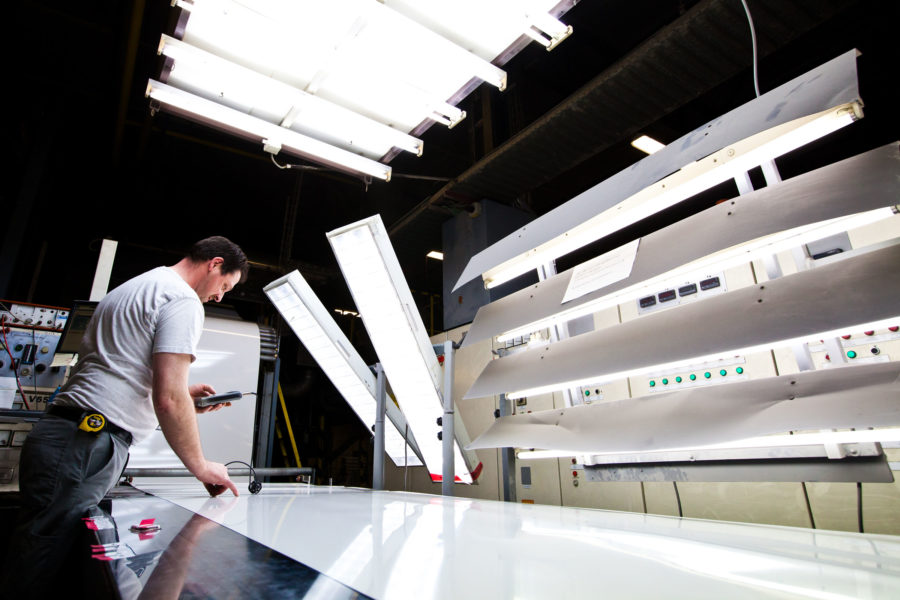Story at a glance:
- Design professionals need to familiarize themselves with the materials used in visual display systems to make informed purchasing decisions.
- CeramicSteel leads the visual display market in durability, sustainability, and hygienic properties.
- Sustainability no longer simply refers to environmental stewardship; social responsibility is becoming more important to customers.
Shopping for a new visual display system can be a challenge, especially for those architects, interior designers, and contractors who are less familiar with the small—but critically important—differences between the materials used to make writing surfaces. Browse any online catalog and you’ll surely be overwhelmed with an endless array of seemingly identical products.
The vast range of prices are the only indication that anything unique lies behind the surface of the whiteboards. But those who think they can save a few bucks by shopping within the middle of the price range may be in for a rude awakening a few years down the line. That’s because, in terms of durability and sustainability, not all materials are created equally.
“With visual display systems like whiteboards, there really is no visual differentiator to demonstrate superiority, so you might not even know the quality of the product you’re buying,” says Guido Vervaeren, product manager for surfaces at Polyvision, a leading manufacturer of visual display system surfaces.
Over several generations Polyvision has perfected the process of fusing porcelain enamel onto steel coils to create CeramicSteel—one of the most popular materials used in the production of whiteboards and other visual display systems.
The firm recently acquired Ohio-based Marsh Industries—one of the original producers of educational writing surfaces—to bring together their respective expertise in manufacturing, design, R&D, and sales under one roof.
“The visual display system market is evolving, and the needs are changing,” Vervaeren says. “Customers want durability, they want a product that is going to look great, and increasingly, they want to work with manufacturers who are socially and environmentally sustainable. And they want all of that for a fair price.”
Finding the right partner who can supply the materials that meet these qualifications can be a daunting task.
The writing surfaces used on the vast majority of visual display systems on the market today are made from either painted steel, melamine, glass, or porcelain enamel. Of course, there are benefits and drawbacks to each, but it’s important for design professionals to familiarize themselves with their respective properties in order to make an informed procurement decision. So what is the cost/benefit analysis on each?

Photo courtesy of Marsh by Polyvision
Painted Steel
“Painted steel is, well, just that—it’s a steel sheet that has been coated with a thin layer of paint,” Vervaeren says. Common in educational settings, painted steel whiteboards are by far the most affordable choice, but that is essentially where their advantage ends. That is because, as an organic compound, the paint coating is inherently soft and easily scratchable.
When a painted steel whiteboard inevitably gets a scratch mark, the ink from the dry erase marker will remain within those fissures. The surface also succumbs to normal wear and tear, dulling much faster than competing materials. “Within a short period of time, that board is going to look awful and will need to be thrown away and replaced,” Vervaeren says. That makes painted steel neither a sustainable nor long-term solution, which is reflected in the short duration of the warranties on these products.

Photo courtesy of Marsh by Polyvision
Melamine
Another affordable material for writing surfaces is melamine, also known as Formica. Melamine is a nitrogen-rich organic resin that is more commonly used to make everyday household items like mid-market dishware and utensils.
To make visual display boards, a coating of melamine is generally infused onto a hard substrate board like a high-pressure laminate core. Melamine boards are therefore not magnetic themselves unless a steel sheet is placed within the core as well. And as a softer, organic material, melamine boards have a similar durability and lifespan as painted steel.
Glass
Many of the visual display boards on the market today are made from glass. With a glossy, high-end appearance, glass whiteboards are popular in the commercial office market for their functionality and visual flair. They are generally made from thick, tempered glass panes that have been painted on the backside. And unlike painted steel or melamine boards, glass does not scratch easily.
A shiny finish can go too far, however. “Glass boards with an extremely high gloss level may be disturbing and difficult to read off of, as the material is slightly transparent,” Vervaeren says.
And while they are resistant to simple scratch marks, a heavier blow will cause them to shatter—which is one reason they are not commonly found in schools. They are also more expensive than painted steel or melamine, which means you are essentially paying a premium for form over function.
Porcelain Enamel
That brings us to porcelain enamel—the material used as the coating on Polyvision’s CeramicSteel surfaces. The porcelain enamel starts as a slurry of very finely ground porcelain particles, which is applied in a thin layer on a .019-inch steel coil. The steel and porcelain slurry are then fired in a furnace at up to 1500 degrees Fahrenheit, fusing the materials together into CeramicSteel.
“This proprietary process creates a product that is so durable, there’s no way you can use it in which it will eventually wear down,” Vervaeren says. “That’s why, unlike our competitors, we’re able to offer a lifetime warranty on these surfaces.” The CeramicSteel writing surface is then secured to a fiberboard core, along with a variety of other finishes, to create Marsh’s suite of visual display systems.
How is CeramicSteel Sustainable?
On top of its many direct benefits to users, CeramicSteel is also one of the most sustainable materials utilized in the visual display market. It boasts an impressive roster of certifications: LEED, FSC, Indoor Advantage Gold, and, most impressively, Cradle to Cradle Bronze.
“Polyvision was actually one of the first companies in Western Europe to obtain Cradle to Cradle certification, which is one of the most stringent and thorough processes out there,” Vervaeren says. Cradle to Cradle assesses materials and products using five criteria: material health, product circularity, clean air and climate protection, water and soil stewardship, and social fairness.
How does CeramicSteel meet these metrics? To start, any and all scrap from the production process is 100% recyclable. “We ship back all of our waste to the steel manufacturer, who uses the scrap to feed their blast furnace,” Vervaeren says. “This creates a circular economy where we aren’t wasting virgin materials.” The finished whiteboards are recyclable as well; the CeramicSteel just needs to be separated from the substrate backing.

Photo courtesy of Marsh by Polyvision
Social Sustainability is Important, Too
Social fairness metrics ensure a company not only treats its own community and employees in an ethical manner, but that this ethos permeates its entire supply chain as well. Polyvision and Marsh completed a social responsibility audit and developed a positive impact strategy in order to achieve certification.
On top of that, a socially responsible company ensures that its products don’t negatively impact the health of its customers. CeramicSteel meets the certification for Indoor Advantage Gold because no volatile materials or dangerous solvents are used in its production.
In traditional visual display systems, the adhesives and other toxic compounds that hold the various materials together slowly seep out of the finished product over time, which can cause headaches and have other adverse health effects. “With CeramicSteel, we can guarantee for our customers that our whiteboards will never be detrimental to the air quality in a classroom or office,” Vervaeren says.
How Hygienic is CeramicSteel?
As we settle into a world where Covid-19 is likely to be endemic, products that offer hygienic benefits are popping up left and right. Call it foresight or just plain good luck, but Polyvision and Marsh beat the market by a few years in this regard.
“When we first introduced Hygienic CeramicSteel a few years ago, the reaction was ‘OK, that’s cool,’” Vervaeren says. “But now with coronavirus, you can imagine how popular it is.”
Hygienic CeramicSteel incorporates an additive of silver microparticles embedded within its surface that is formulated to self-clean within 24 hours. “Silver is a well-known antimicrobial agent,” Vervaeren says, “This feature alone will save you from using gallons of cleaning spray each year.”




